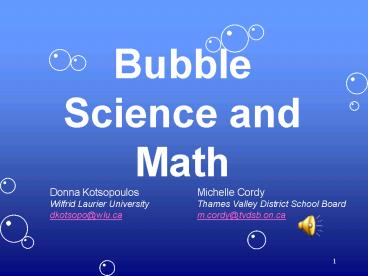Bubble Science and Math PowerPoint PPT Presentation
1 / 14
Title: Bubble Science and Math
1
Bubble Science and Math
Donna Kotsopoulos Michelle Cordy Wilfrid Laurier
University Thames Valley District School
Board dkotsopo_at_wlu.ca m.cordy_at_tvdsb.on.ca
2
About bubbles
- Bubbles are made from bubble film
- Bubble film has may properties that have been
learned about through experiments.
3
Our goals ...
- Our goal today is to discover some of the
properties of bubble film. - Experiment 1 The Bubble Trampoline
- Experiment 2 Woolly Jumper
- Experiment 3 Imagining Bubbles
- Experiment 4 Cubical Bubbles
4
Experiment 1 The Bubble Trampoline
- What did we learn
- Bubble film is elastic and stretches. This is
what allows bubble film to make bubbles.
5
Experiment 2 Woolly Jumper
- What did we learn
- The tension in the bubble film will always try
to shrink the film to make the smallest surface
possible.
6
Experiment 3Imagining Bubbles
- Make bubble blowers in a variety of shapes.
- Predict the shape of the bubble.
- What did we learn
- Bubble film always forms
- the shape of a sphere.
Recipe for bubbles
7
- ?
- Why is it that when we blow
- bubbles with all these
- different shapes, the
- bubble is always a sphere?
8
What do we know about bubble films
- The surface of bubble films is elastic
- The surface of bubble films stretches
- The shape of bubble films is always a sphere
- The surface area of bubbles will always try to
shrink to make the smallest amount of surface
area. - Bubble films always make the shape of a sphere
because spheres have the smallest surface area
for a given volume.
9
Experiment 4Cubical Bubble
- Imagine what shape the bubble film will be inside
the cube. - What is your prediction about the kind of bubble
that will be made inside the cube?
10
Why is the shape insidea cube a sphere?
- When bubbles and bubble films meet, they always
obey certain - rules
- Films and edges always meet each other at equal
angles (based on 360 degrees), so three films
meeting at an edge will be 120 and four films
will be 90 apart - There are never more than two films at an edge
- There can never be more than four edges or six
films meeting at a point. - These rules are known as the "Golden Rule of
Bubbles."
11
What next .
- How can we be sure that the sphere has the
smallest surface area? - What can we do to prove this?
12
References
http// questacon.edu.au/html/bubbles.html
13
Questions and Feedback
- Donna Kotsopoulos
- Wilfrid Laurier University
- dkotsopo_at_wlu.ca
- Michelle Cordy
- Thames Valley District School Board
- m.cordy_at_tvdsb.on.ca
14
Recipe for bubbles
- 3 parts dishwashing liquid
- 7 parts hot water
- 1 part glycerol (or sugar)
- The glycerol or sugar helps the bubbles to last
longer, by preventing them from drying out - Mix the ingredients very thoroughly
- Bubble mix gets better with age
- Bubbles burst when they dry out, so the more
humid it is the longer they last - Bubbles work best at night, in the shade and
while it is raining - Froth on the top can interfere with making
bubbles.

